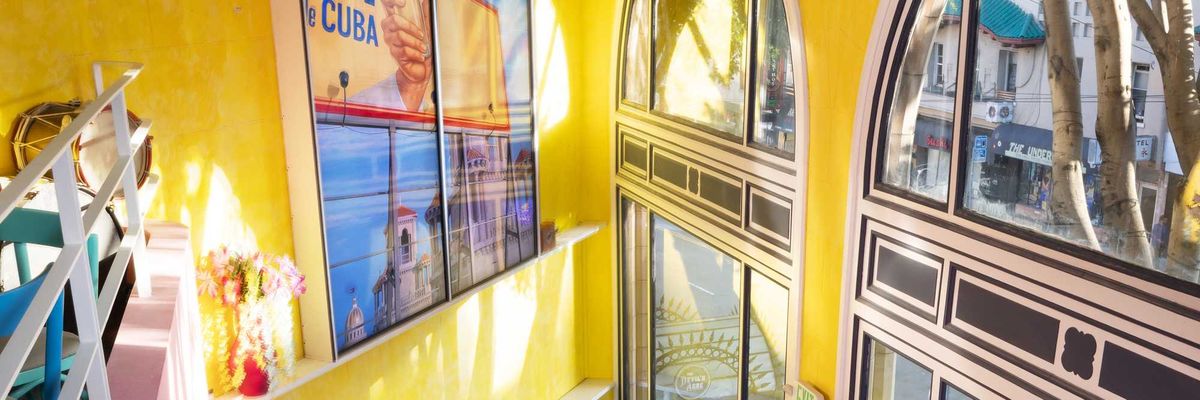Erik Anderson didn't seem particularly interested in talking about his time in culinary school, which he described as "not very beneficial" for chefs seeking work in the U.S.; or in trying to describe the so-called modern American cuisine he made at The Catbird Seat in Nashville; and only marginally more interested in talking about his stage at Noma, other than to say "I think it would've had to have influenced my working method."
What he was interested in discussing was the fact that of all the fish, sturgeon is the fish that is most like a bird in that the sturgeon has a gizzard. Why this is relevant is that on the night in early March that I ate at Coi, I requested a pescatarian tasting menu, whereas Anderson prefers working with birds, or as he put it, "I like cooking things that fly."
The chef-restaurateur Daniel Patterson opened Coi in 2006, and for the next nine years spent the better part of his waking hours in its kitchen. At the end of 2015, Patterson passed the toque to Matthew Kirkley, who in the fall of 2017 took the restaurant from two Michelin stars to three, just before setting off to France to compete in the prestigious gastronomic competition, the Bocuse d'Or. On the verge of his departure, Kirkley approached Anderson, who subsequently discussed the idea over dinner at Patterson's house, where they sealed the deal. In the transitional period, Patterson returned to the kitchen for six weeks to prepare what Anderson described as a Coi greatest hits menu.
"It served the purpose of me being able to kind of get into the surroundings and meet some of the farmers and purveyors and see their produce," said Anderson. "Secondly," he continued, "it was cool to be able to see that food again, the iconic Coi dishes," among them, California sturgeon caviar with egg yolk poached in smoked oil; grilled abalone with farro, white miso and seaweed; and matsutake mushrooms with potato and a pine needle puree.
Today, the menu is Anderson's design, exclusively. "Daniel's very progressive-thinking," he explained. "He doesn't have a problem with his restaurant evolving and growing. He's very cool with the fact that his restaurant changes and grows. You can't stay the same. If you're frozen in time, you lose relevance."
Being the furthest thing from an authority on trends in Champagne, I can't really comment on the relevance of the Lenoble Brut Rosé that kicked things off, but I can say that its chewy, tannic, dry-sour-cherry-ness was precisely the kind of tonic you need before setting off on a 10-course tasting menu, or 11 if you count the mignardises.
The amuses-bouches were tiny and flavor-packed: an impossibly light and wonderfully bright citrus marshmallow that resembled a kind of Art Deco jewel; and a minuscule tartlet filled with sunchokes that had been ever so slowly caramelized in butter, and topped with a savory crumble made from caramelized milk and toasted sunflower seeds.
The next dish, moving up somewhat in scale, was geoduck, a clam which can live more than 100 years and grow to a size of more than 10 pounds, although in this case, cut into very thin slices and served in a small steep-walled cup with a bit of very subtly clammy clam jelly (made from geoduck and Manila clams), a rich avocado mousse, and some micro-thin slices of green onion which imparted the slightest and most delightful essence of allium.
Dungeness crab, in the form of a terrine, was a study in pale—a thin white slab of tender meat poached in court-boullion and lightly bound in a scallop mouse, topped with a delectably flavored glaze made of citrus-leaf-infused cream; and arranged just so around the terrine, a scattering of vividly flavored black sesame puree, some tiny juicy spheres of Shinko pear, and enticing little orbs of delicately sweet-citrusy lemongrass panna cotta.
At this point, the aforementioned sturgeon appeared, white sturgeon to be precise, first in the form of a generous mound of caviar that concealed beneath it a dab of egg yolk, which, cooked for an hour in oil at a low temperature, had an appealingly custardy texture; then in a little white cut poached in rendered chicken fat and dressed in a lemon-zest-infused buerre blanc; and finally, cloaked in a gaily decorated piecrust in the company of similarly tender, meaty morsels of scallop and lobster.
The savory denouement: an intensely, deliciously rich dish of lobster, cooked over hot-burning Japanese charcoal and garnished with tempura-fried maitake and black trumpet mushrooms and a lightly sweet onion syrup.
Eventually, one needs a break from richness, and the perfectly timed pivot was as refreshing as it was refreshingly simple: a thin sliver of etrog—an ancient citrus variety that is mostly rind—infused with bittersweet Meletti Amaro and served on a mound of crushed ice.
Coi's pastry chef, Riley Redfern, continued in a citrusy vein with an icy-creamy blood orange sorbet made from a mix of marshmallows and blood orange juice, deep-frozen and pureed to a velvety consistency by a device called a Pacojet, which sounds quite technical, but is simply scrumptious. Redfern describes the flavor as that of a "dreamsicle." To get to the sorbet, you must dismantle a shield of delicate, sweet-tart candy discs—a highly enjoyable pursuit. A chocolate millefeuille was similarly impressive, a low-rise modernist edifice made up of alternating layers of flourless chocolate cake, crémeux, coffee crème and tempered chocolate—crisp, then creamy, then custardy, then gone.
(Nick Czap)
For the amuses-bouches, a minuscule sunchoke tartlet topped with a savory crumble of toasted sunflower seeds (left) and a bright citrus marshmallow.



// Coi, 373 Broadway (North Beach), coirestaurant.com





















